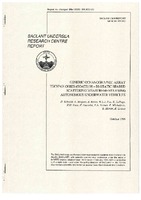| dc.contributor.author | Schmidt, Henrik | |
| dc.contributor.author | Maguer, Alain | |
| dc.contributor.author | Bovio, Edoardo | |
| dc.contributor.author | Fox, Warren L. J. | |
| dc.contributor.author | LePage, Kevin D. | |
| dc.contributor.author | Pace, Nicholas G. | |
| dc.contributor.author | Hollett, Reginald D. | |
| dc.contributor.author | Guerrini, Piero | |
| dc.contributor.author | Sletner, Per Arne | |
| dc.contributor.author | Michelozzi, Enzo | |
| dc.contributor.author | Moran, B. | |
| dc.contributor.author | Grieve, R. | |
| dc.date.accessioned | 2018-10-11T14:08:51Z | |
| dc.date.available | 2018-10-11T14:08:51Z | |
| dc.date.issued | 1998/10 | |
| dc.identifier | 12184 | |
| dc.identifier.govdoc | SR-302 | |
| dc.identifier.uri | http://hdl.handle.net/20.500.12489/524 | |
| dc.description.abstract | The GOATS'98 experiment was performed May 5-29, 1998 in shallow water off Marciana Marina, on the island of Elba, Italy. The experiment addressed some of the fundamental issues associated with using the new Autonomous Ocean Sampling Network (AOSN) concept for mine countermeasures and rapid environmental assessment in shallow, and potentially very shallow water. A parametric source mounted on a tower was used to insonify proud and buried seabed targets. Target scattering and reverberation were measured by several fixed arrays and a mobile array mounted on an autonomous underwater vehicle. This extensive receiving array capability was used to map the full 3-D structure of scattering and reverberation, the objective being to identify 3-D acoustic features which distinguish targets from the reverberant background and which may, therefore, be exploited for combined detection and classification. The concurrent use of the AUV addressed various issues associated with the use of the AOSN concept for measuring such features by providing mobile platforms for both mono, bi and multistatic sonar congurations. The experiment demonstrated clearly that AUV technology is now sufficiently mature to enable small, inexpensive vehicles to be operated reliably in very shallow water, launched and recovered from a surface ship offshore. The excellent quality of the 3-D acoustic data sets recorded during the experiment demonstrated that AOSN technology should provide extremely useful acoustic platforms for new sonar concepts in littoral MCM. | |
| dc.format | vi, 62 p. : ill. ; 41 fig. | |
| dc.language | English | |
| dc.publisher | NATO. SACLANTCEN | |
| dc.relation.ispartofseries | ADA376854 | |
| dc.subject | Elba Island | |
| dc.subject | GOATS'98 trial | |
| dc.subject | Tyrrhenian Sea | |
| dc.subject | Shallow water | |
| dc.subject | Autonomous Underwater Vehicles (AUV) | |
| dc.subject | Multistatic sonar | |
| dc.subject | AOSN (Autonomous Ocean Sampling Network) | |
| dc.subject | Mine burial and bottom conditions | |
| dc.subject | Buried objects detection | |
| dc.subject | Acoustic scattering by elastic structures | |
| dc.title | Generic Oceanographic Array Technologies (GOATS)'98: bi-static seabed scattering measurements using autonomous underwater vehicles | |
| dc.type | Scientific Report (SR) | |
